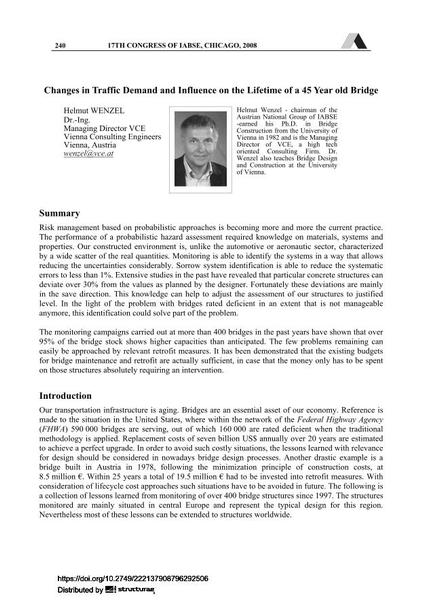Changes in Traffic Demand and Influence on the Lifetime of a 45 Year old Bridge

|
|
|||||||||||
Détails bibliographiques
| Auteur(s): |
Helmut Wenzel
(Managing Director VCE, Vienna Consulting Engineers, Vienna, Austria)
|
||||
|---|---|---|---|---|---|
| Médium: | papier de conférence | ||||
| Langue(s): | anglais | ||||
| Conférence: | 17th IABSE Congress: Creating and Renewing Urban Structures – Tall Buildings, Bridges and Infrastructure, Chicago, USA, 17-19 September 2008 | ||||
| Publié dans: | IABSE Congress Chicago 2008 | ||||
|
|||||
| Page(s): | 240-241 | ||||
| Nombre total de pages (du PDF): | 9 | ||||
| Année: | 2008 | ||||
| DOI: | 10.2749/222137908796292506 | ||||
| Abstrait: |
Risk management based on probabilistic approaches is becoming more and more the current practice. The performance of a probabilistic hazard assessment required knowledge on materials, systems and properties. Our constructed environment is, unlike the automotive or aeronautic sector, characterized by a wide scatter of the real quantities. Monitoring is able to identify the systems in a way that allows reducing the uncertainties considerably. Sorrow system identification is able to reduce the systematic errors to less than 1%. Extensive studies in the past have revealed that particular concrete structures can deviate over 30% from the values as planned by the designer. Fortunately these deviations are mainly in the save direction. This knowledge can help to adjust the assessment of our structures to justified level. In the light of the problem with bridges rated deficient in an extent that is not manageable anymore, this identification could solve part of the problem. The monitoring campaigns carried out at more than 400 bridges in the past years have shown that over 95% of the bridge stock shows higher capacities than anticipated. The few problems remaining can easily be approached by relevant retrofit measures. It has been demonstrated that the existing budgets for bridge maintenance and retrofit are actually sufficient, in case that the money only has to be spent on those structures absolutely requiring an intervention. |
||||
